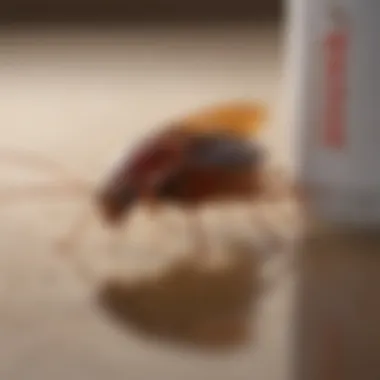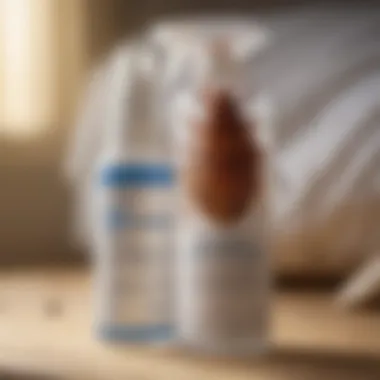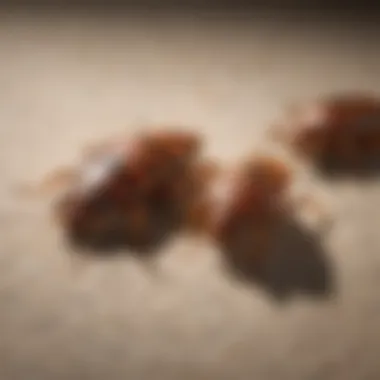Evaluating Bed Bug Spray Effectiveness Against Roaches


Intro
In recent years, urban households have seen a rise in pest infestations, notably from bed bugs and cockroaches. With the overlapping presence of these pests in many environments, homeowners often seek effective solutions that can tackle multiple infestations simultaneously. This article investigates the efficacy of bed bug sprays as a potential method for controlling cockroach populations. Through a detailed analysis of the active ingredients within bed bug sprays, we will delve into their specific targeting mechanisms and explore how such products might serve in integrated pest management strategies.
Understanding the utility of bed bug sprays against cockroaches may offer an alternative path for homeowners, reducing reliance on multiple chemicals and promoting more environmentally conscious pest control methods. Let’s delve into the details.
Pest Identification
Detailed Descriptions of Common Pests
Before embarking on any pest control measures, identifying the pests involved is crucial. Cockroaches and bed bugs, while both unwelcome guests in any home, possess distinct characteristics.
Cockroaches are flat-bodied insects, generally brown or black, with long antennae. They thrive in warm and humid spaces, often nesting in kitchens and bathrooms. Notably, species such as the American cockroach and German cockroach are commonly found in urban areas.
Bed bugs, on the other hand, are small, oval, and reddish-brown insects that feed on the blood of humans and animals. They are primarily found in bedding, mattresses, and furniture. Their bites often lead to red, itchy welts on the skin.
Signs and Symptoms of Infestations
Recognizing the signs of infestation helps in implementing timely control measures.
For cockroaches:
- Droppings: Small, dark pellets found in areas where they travel.
- Egg cases: Small, brown capsules indicating breeding.
- Foul odor: A musty smell indicative of a large infestation.
For bed bugs:
- Bite marks: Red, itchy welts that appear in clusters.
- Blood stains: Tiny spots on bed linens from crushed bugs.
- Shed skins: Molted exoskeletons near hiding spots.
Observation is key. Identifying the presence of these pests early can mean the difference between an easily managed situation and a larger infestation.
Prevention Strategies
Home Maintenance Tips for Pest Prevention
Maintaining a clean home significantly reduces the likelihood of pest infestations. Here are some essential practices:
- Seal gaps and cracks: Close off potential entry points around doors, windows, and foundations.
- Food storage: Store all food items in airtight containers to limit access.
- Regular cleaning: Frequent vacuuming aids in detecting and eliminating both pests and their eggs.
Natural Deterrents and Barriers
Integrating natural deterrents can be an effective preventative approach:
- Diatomaceous earth: This natural powder can be sprinkled in areas known for pest activity. It is desiccating to insects like cockroaches.
- Essential oils: Scents like peppermint and tea tree oil are known to repel both roaches and bed bugs.
- Soap and water solution: A mixture may suffocate insects on contact, providing immediate management.
Treatment Options
Overview of Chemical vs. Natural Treatments
When faced with an infestation, understanding the treatment options is crucial. Chemical treatments often include various insecticides that may also be effective on roaches or bed bugs. However, many homeowners prefer natural solutions due to their lower toxicity to humans and pets.
Step-by-Step Guides for DIY Treatments
Implementing a DIY pest control approach can be quite efficient. Here’s a straightforward method to utilize bed bug spray against cockroaches:
- Identify the area: Locate spots with visible roach activity.
- Choose appropriate spray: Ensure the bed bug spray contains effective active ingredients like deltamethrin or imidacloprid.
- Apply carefully: Follow the manufacturer's instructions, aiming for crevices and known hiding spots.
- Follow up: Regular treatment may be necessary to eliminate any residual population.
Using bed bug spray may not be the primary solution for cockroach control, but it can be part of a larger strategy to manage pests in the home effectively.
Culmination
In summary, while bed bug sprays target mainly bed bugs, their application might show varying degrees of efficacy against cockroaches. As the understanding of pest behavior and chemical interactions evolves, homeowners should remain informed about using such products wisely in integrated pest management practices.
Prelude to Pest Control
Pest control is a crucial aspect of maintaining a healthy and comfortable living environment. Household pests such as bed bugs and cockroaches not only pose a nuisance but can also affect the well-being of residents. Understanding pest control is vital for homeowners seeking to effectively manage infestations and minimize risks associated with these pests.
Recognizing the importance of pest control involves several elements. First, it highlights the necessity for knowledge about different pests. This includes understanding their behavior, habitats, and the risks they present. Homeowners can then make informed choices regarding prevention and elimination strategies.
Second, pest control provides a framework for assessing the array of products available. There are many insecticides on the market, each formulated for specific pest challenges. Given that bed bug sprays are often considered for cockroach control, it is essential to understand how these products work and their suitability for various pest types.
Lastly, considering the integrated approach to pest management allows homeowners to combine methods for optimal results, beyond just relying on chemical solutions. This perspective fosters long-term solutions, ensuring that pest control is not only reactive but also preventative.


Effective pest control not only protects the home but also enhances the quality of life for its inhabitants. This article addresses the relationship between bed bug sprays and cockroach populations to explore the potential benefits and efficiency of these insecticides in broader pest management strategies.
Understanding Common Household Pests
Household pests vary in type and habit. Bed bugs and cockroaches are two among many pests often found in homes. Understanding their characteristics is key to effective management. Bed bugs are small, nocturnal insects that feed on human blood. They often hide in bedding, furniture, and any crevices. They reproduce quickly, leading to large infestations if not addressed promptly.
Cockroaches, on the other hand, are more versatile in their environments. These pests can be found in kitchens, basements, and even bathrooms. They are known for their rapid reproduction and resilience to various control methods. Cockroaches are omnivorous and can survive on a wide range of substances. Their presence indicates unsanitary conditions, often linked to poor cleanliness or food sources available in the home.
A clear distinction between these pests is necessary because it influences the types of insecticides utilized during treatment. Homeowners must recognize the specific needs for controlling each species.
The Role of Insecticides in Pest Management
Insecticides play an essential role in managing pest populations within homes. They work by targeting specific vulnerabilities in pests, ultimately eradicating them. Different insecticides are designed with specific active ingredients to target the nervous system or metabolic pathways of pests like bed bugs and cockroaches.
When choosing an insecticide, one must consider several factors. Effectiveness is paramount. However, safety for humans and pets is equally important. Bed bug sprays often contain pyrethroids or neonicotinoids. These chemicals can have different effects on various pests.
Moreover, the application method affects efficacy. Aerosol sprays may penetrate harder-to-reach areas, while liquid formulations may be better for surface applications. Each product's label provides important details about where and how to use it effectively.
Insecticides should be used as part of a larger pest management strategy, integrating sanitation and exclusion techniques for optimal results.
Homeowners must be aware of the potential consequences of over-relying on chemical treatments. This balance is crucial to ensure long-lasting pest control while preventing resistance development among pests.
Overview of Bed Bug Sprays
The significance of understanding bed bug sprays in relation to pest management cannot be overstated. Bed bug infestations pose unique challenges for homeowners and pest control professionals. This subsection aims to unravel the complexities behind bed bug sprays and their potential impact on other household pests, particularly cockroaches. Knowing the composition and action of these products provides homeowners light into their utility and effectiveness against various insects.
Composition and Active Ingredients
Bed bug sprays typically contain a mix of active ingredients designed to target the biology of bed bugs specifically. Common ingredients include pyrethroids, neonicotinoids, and insect growth regulators. Each of these components plays a distinct role:
- Pyrethroids: A synthetic class of chemicals similar to natural insecticides derived from chrysanthemums. They disrupt the nervous system of insects upon contact or ingestion.
- Neonicotinoids: These act on the same neural pathways as nicotine, effectively immobilizing and killing pests that encounter them.
- Insect Growth Regulators (IGRs): IGRs are not directly lethal but disrupt the development of bed bugs, preventing them from maturing and reproducing.
Understanding these ingredients is crucial for homeowners. While such compositions may be effective against bed bugs, their efficacy against cockroaches is ambiguous and merits further exploration.
Mechanism of Action Against Bed Bugs
The action mechanism of bed bug sprays varies with the active ingredients used. Typically, they function primarily through the following processes:
- Neurotoxic Effects: Combined effects of pyrethroids and neonicotinoids primarily target the nervous system of bed bugs. When bed bugs come in contact with these sprays, they experience paralysis and subsequent death.
- Disruption of Development: IGRs interfere with the molting process of bed bugs, making it impossible for the insects to transition to their next life stage. This further limits the population growth in infested areas.
- Contact and Ingestion Toxicity: Depending on the formulation, sprays may be lethal through direct contact or when ingested, covering multiple pathways to eliminate bed bugs.
The focus on these mechanisms clarifies how bed bug sprays function as tools for pest management. As we analyze their effectiveness against cockroaches, it becomes evident that the distinct physiological differences between these pests likely results in varied outcomes. Therefore, the application of heated strategies and methodologies in integrated pest management must account for these unique characteristics.
"Understanding the function of these sprays can guide homeowners in making informed choices regarding pest control strategies."
Identify Cockroaches
Understanding the various types of cockroaches is vital in the context of pest control, especially when evaluating the potential efficacy of bed bug sprays against these insects. Each species of cockroach possesses unique characteristics that can influence the effectiveness of treatments designed for another pest. By familiarizing oneself with the common species found in households and their behaviors, homeowners can better position themselves in combating potential infestations.
Common Species Found in Households
In the United States, there are several species of cockroaches commonly found in residential environments. The most prevalent include:
- German Cockroach: Known for its rapid ability to reproduce, the German cockroach is a small, light brown insect typically found in kitchens and bathrooms.
- American Cockroach: Larger than the German variety, this reddish-brown cockroach is often found in basements or sewers, making its way indoors through plumbing.
- Oriental Cockroach: Often mistaken for a beetle, the Oriental cockroach has a shiny black color and prefers cooler environments, such as basements.
- Brown-banded Cockroach: Smaller in size, this cockroach is often found in higher places in the home, such as on walls and ceilings, favoring warmer areas.
Recognizing these species is crucial because each has different behaviors and responses to treatments, including bed bug sprays. A specific approach may be needed depending on the species involved.
Behavior and Habitat Preferences
Cockroaches are resilient creatures, known for their adaptability to various environments. Their behavior significantly affects how they interact with their surroundings, including human dwellings. Important aspects of their behavior include:
- Nocturnal Activity: Most cockroaches are nocturnal, meaning they come out primarily at night, making them harder to detect during the day.
- Sheltering Habitats: Cockroaches prefer to hide in dark, warm, and damp areas, such as behind appliances, under sinks, and in cracks and crevices. This behavior complicates detection and treatment.
- Food Preferences: Roaches are omnivorous scavengers, consuming a wide range of food items. They can thrive on leftovers, decaying organic material, and even paper products. This dietary versatility makes them persistent pests in the home.
Recognizing these behaviors aids homeowners in pinpointing potential infestations and understanding how cockroaches respond to different pest control measures, including the use of bed bug sprays.
Remember: different species have different needs and behaviors. Understanding these can greatly impact the effectiveness of pest management strategies.
Comparative Analysis
In pest control discussions, the comparison between different insects is crucial. Understanding Comparative Analysis helps to evaluate the effectiveness of control measures across various species, particularly when considering products designed for one type of pest, such as bed bugs, and their potential effectiveness against another, like cockroaches. This section focuses on several key elements.
One major benefit of comparative analysis is the capacity to assess chemical interactions. Bed bug sprays often contain active ingredients that target specific biological functions in bed bugs. Analyzing their impact on cockroaches reveals whether these sprays will function effectively against non-target pests. Furthermore, contrasting these species highlights their behavioral and physiological differences, which can inform homeowners about what products to choose for pest management.
"Comparison of pest profiles can illuminate the potential for cross-species efficacy in pest control products, leading to more informed decisions for pest management."


When evaluating pest control strategies, it is also important to recognize the considerations involved. There are safety implications, environmental factors, and financial costs related to pesticide application. Homeowners can benefit from understanding these aspects, as they can mitigate risks associated with ineffective treatments. The comparative analysis can uncover the limitations of bed bug sprays when dealing with cockroaches, underscoring the need for a diversified pest management approach.
Bed Bugs vs. Cockroaches: A Biological Perspective
Bed bugs (Cimex lectularius) and cockroaches (Blattella germanica) exhibit significant biological differences that influence the effectiveness of pest control products. Bed bugs are ectoparasites, feeding on blood, while cockroaches are omnivorous scavengers that consume a variety of organic materials. This difference in diet leads to variations in their habitats and behavior, which is an important consideration in pest management.
The biology of these pests dictates their responses to insecticides. For instance, bed bugs have developed a resilience to certain chemicals over time, often requiring targeted approaches for effective control. Conversely, cockroaches have different behavioral patterns, often hiding during the day and coming out at night, making them harder to control with non-targeted insecticides. Understanding these biological variations allows for a more informed application of pest control products, particularly when evaluating the suitability of bed bug sprays for cockroach infestations.
Differences in Pest Control Products
Pest control products vary significantly based on their intended target species. Bed bug sprays typically contain specific active ingredients designed to eliminate bed bugs by disrupting their nervous system or preventing them from feeding. For example, ingredients like Pyrethroids and Neonicotinoids are common in these formulations.
In contrast, products meant for cockroach control might use different active ingredients tailored to disrupt the cockroach’s metabolism or reproductive system. Ingredients such as Boric Acid and Fipronil are more common in roach control products.
When comparing these products, here are important distinctions to note:
- Targeted Efficacy: Bed bug sprays may not impact cockroaches directly because they aren't formulated with their biology in mind.
- Application Methods: Bed bug sprays are often applied as surface treatments, while cockroach control might involve bait stations or gel formulations.
- Residual Effects: Some bed bug products are designed for immediate knockdown, while roach baits work over a longer time period to eliminate populations.
Ultimately, recognizing how these differences affect treatment decisions can lead to better pest management systems. Homeowners should consider using products specifically designed for the pest at hand, to enhance the likelihood of successful eradication.
The Impact of Bed Bug Sprays
Bed bug sprays are often perceived as a targeted solution to a significant household problem: the presence of bed bugs. However, their implications extend far beyond this primary focus, especially when considering their potential influence on other pests like cockroaches. Understanding the impact of bed bug sprays is crucial, as these products might be relevant in creating a holistic pest management strategy.
The primary benefit of understanding bed bug sprays lies in their active ingredients. These chemicals are specifically designed to target the unique biology of bed bugs. Ingredients commonly found in these sprays include pyrethroids, neonicotinoids, and diatomaceous earth. Each operates differently, disrupting the insects' nervous system or causing dehydration. When assessing their efficacy against cockroaches, it is important to evaluate if these same properties effectively manage such a different pest species. The inherent differences in the physiology and behavior of cockroaches necessitate that we tread carefully in assuming cross-effectiveness.
It's essential to consider not just the effectiveness, but also the safety of using bed bug sprays in environments where children or pets are present. Many bed bug sprays are designed for indoor application, thus pose certain risks if used without proper care.
Furthermore, an understanding of the environmental impact of these sprays cannot be overlooked. Their application may affect other species in the ecosystem, highlighting the need for their careful usage within an integrated pest management approach. Sustainable practices that minimize harm to non-target insects while still managing pest populations provide a balanced outlook in pest control.
"The impact of bed bug sprays is not simply about elimination; it's about creating an environment inhospitable to all pests and maintaining a safe living space."
Effectiveness against cockroaches is one area that commands attention. Examining research and anecdotal evidence will help clarify how these sprays interact with the cockroach population. Addressing this aspect will create a foundation for future strategies homeowners can employ.
Effectiveness Against Cockroaches
When discussing the impact of bed bug sprays on cockroaches, exploring their effectiveness is essential. The chemical compositions of these sprays have been primarily developed to target bed bugs. However, some studies indicate that certain active ingredients may also affect cockroach populations.
The effectiveness of these sprays against cockroaches varies significantly. Research shows that while some ingredients can immobilize or kill cockroaches, the results are not consistently reliable. Cockroaches have a unique biology that allows them to adapt to various environments, including developing resistance to insecticides over time. This makes it critical to identify which specific bed bug sprays may offer any benefit against these resilient pests.
Factors influencing the effectiveness include:
- Chemical composition: Specific ingredients may have varying levels of efficacy against cockroaches.
- Concentration of active ingredients: Higher concentrations may offer better results, although they also come with higher risks.
- Application method: How the spray is applied can significantly impact its effectiveness in controlling a cockroach infestation.
Understanding these subtleties can help homeowners make informed decisions about pest control methods.
Field Studies and Expert Opinions
Field studies and expert opinions contribute much to understanding the effectiveness of bed bug sprays against cockroaches. Research frequently highlights the need for further investigation due to the complexities involved in pest behavior and chemistry. Some studies suggest that while bed bug sprays can kill cockroaches on contact, their residual effects may not disrupt the broader population significantly.
Experts often underscore the importance of an integrated approach to pest management. They advocate for utilizing various strategies rather than solely relying on bed bug sprays. Recommendations include:
- Regular monitoring: Keeping an eye on pest activity to determine the need for intervention.
- Combination of methods: Integrating traps and baits with chemical sprays can yield better outcomes.
- Educational resources: Homeowners should stay informed about the latest pest management techniques. This could involve seeking expert advice, attending community workshops, or researching reputable sources online.
In essence, field studies and expert insights illuminate the complexities surrounding the usage of bed bug sprays against cockroaches. This understanding equips homeowners with the knowledge needed to navigate pest control effectively.
Integrated Pest Management Considerations
Integrated Pest Management (IPM) is crucial for addressing pest issues in a sustainable and effective manner. It emphasizes a holistic approach to pest control, ensuring methods used are environmentally friendly and socially responsible. This concept involves understanding pest biology, behavior, and ecology, to apply various control tactics customized to specific situations. In the context of assessing the efficacy of bed bug sprays against cockroaches, integrating these strategies allows homeowners to combat multiple pest populations more efficiently.
By utilizing IPM, homeowners can achieve a comprehensive pest management plan. This includes consideration of both chemical and non-chemical methods, which can lower the reliance on pesticides alone. In doing so, households can avoid health risks associated with excessive chemical exposure while effectively managing pest populations.
Another critical element is monitoring. Regular inspection and monitoring of pest activity can provide insights into the most effective control methods. This enables property owners to take proactive measures before infestations get out of hand.
Using Multiple Approaches
In pest management, one approach seldom suffices on its own. Using multiple approaches can significantly increase the chances of successful pest control. Bed bug sprays may offer limited efficacy against cockroaches; thus, combining them with other methods can enhance overall effectiveness.
Consider these strategies for an integrated approach:
- Chemical Insecticides: Use sprays specifically formulated for cockroaches, alongside bed bug treatments, targeting both pests where necessary.
- Physical Barriers: Seal cracks and crevices to limit entry points for cockroaches; this prevents reinfestation and protects against bed bugs travel.
- Sanitation Practices: Maintain cleanliness by regularly cleaning areas where food is stored or consumed. This reduces attractants for cockroaches.
- Habitat Alterations: Change the surroundings to make it less hospitable for pests. This includes adjustments like removing clutter.


Combining these methods can lead to a reduced pest population and lower the likelihood of infestations in the future.
Advantages and Limitations of Bed Bug Sprays
When evaluating bed bug sprays as a tool against cockroaches, it is essential to weigh their advantages and limitations carefully.
Advantages:
- Targeted Application: Many bed bug sprays come with specific targeting mechanisms, allowing for strategic application in areas where pests reside.
- Ease of Use: Generally, bed bug sprays are user-friendly and can be applied quickly without extensive equipment.
- Immediate Action: These sprays often provide rapid knockdown effects, helping to reduce visible pest populations promptly.
Limitations:
- Species Specificity: Bed bug sprays may not be formulated to effectively kill cockroaches, leading to disappointing results.
- Resistance Development: Overuse of specific insecticides can lead to resistance, making future control efforts more challenging.
- Potential Toxins: Some ingredients in bed bug sprays might pose health risks to humans and pets, especially when used in constrained spaces.
Understanding these advantages and limitations helps homeowners make informed decisions on pest control solutions. Engaging in a comprehensive pest management strategy, which evaluates various pest types and their unique needs, tends to yield the best outcomes for keeping homes pest-free.
Alternative Methods for Cockroach Control
The topic of alternative methods for cockroach control holds significant relevance in the context of pest management strategies. While traditional approaches, including the use of bed bug sprays, can offer temporary solutions, a more comprehensive understanding of other methods allows homeowners to adopt a holistic approach. Exploring various alternatives helps to identify effective strategies that may either complement or serve as substitutes for conventional insecticides. Moreover, these methods can cater to specific preferences and situations, providing better outcomes in managing cockroach infestations.
Natural Remedies and Their Efficacy
Natural remedies for cockroach control have gained popularity among homeowners looking for less toxic and environmentally friendly options. Common natural solutions include diatomaceous earth, boric acid, and essential oils.
- Diatomaceous Earth: This is a fine powder made from the fossilized remains of tiny aquatic organisms called diatoms. When roaches come into contact with this substance, it damages their exoskeletons, leading to dehydration and, eventually, death.
- Boric Acid: Often used in the form of bait, boric acid can effectively eliminate cockroach populations. It disrupts their digestive systems, ultimately proving fatal.
- Essential Oils: Oils derived from peppermint, eucalyptus, and tea tree can repel cockroaches. Although their effectiveness may vary, they serve as a safer alternative to potent chemical sprays.
While natural remedies may not always yield immediate results, they can be integrated into a broader pest management strategy. Homeowners should consider that these methods often require consistent application and may work best in conjunction with other tactics.
Chemical Solutions Specifically for Roaches
Chemical solutions are frequently utilized for immediate control of cockroach populations. Products developed solely for roach management differ from bed bug sprays in formulation and active ingredients, which are specifically tailored to combat cockroaches. Key options include:
- Gel Baits: These contain attractants and insecticides that roaches ingest. The slow-acting poison allows the affected roach to return to the nest, where it can eliminate others through contact or feces.
- Insect Growth Regulators: These disrupt the life cycle of roaches, preventing them from maturing into reproductive adults, thereby lowering the population over time.
- Aerosol Sprays: Designed for quick knockdown, these sprays are effective for treating visible infestations, but they may not provide long-term solutions.
"Chemical interventions should be used judiciously, as they can lead to resistance over time among roach populations."
Practical Recommendations for Homeowners
Homeowners play a crucial role in pest management. Proper procedures can significantly impact the effectiveness of pest control measures, especially when dealing with diverse pests such as cockroaches and bed bugs. In this context, understanding how to utilize bed bug sprays, and integrating them into a comprehensive pest management strategy is essential.
Best Practices for Pest Prevention
Preventing pest infestations is always more effective than trying to control them after their establishment. Here are some key strategies for homeowners:
- Maintain Cleanliness: Regular cleaning reduces potential hiding spots for pests. Vacuuming, especially in corners and under furniture, minimizes food sources.
- Seal Entry Points: Inspect your home for gaps and cracks in walls, windows, and doors. Sealing these entry points helps block pest access.
- Proper Food Storage: Store food in airtight containers. This practice not only minimizes food wastage but also attracts fewer pests into your kitchen.
- Regular Inspections: Regularly check common areas for signs of pest activity. Early detection allows for quicker responses.
Pro Tip: Keeping humidity levels low can deter roaches. Consider using dehumidifiers in damp areas.
When to Consult a Professional
Despite best efforts, pests might still find their way into your home. Knowing when to call in an expert is vital to managing infestations effectively. Consider the following:
- Persistent Infestations: If you notice a recurring issue despite DIY treatments, a professional can offer more effective solutions tailored to your situation.
- Extensive Damage: Cockroaches can damage food and health safety, requiring immediate professional intervention.
- Health Concerns: If you or your family members experience allergic reactions or other health issues linked to pest activity, do not hesitate to seek professional assistance.
- Need for Specialized Treatments: Certain insects may need specific treatment methods not achievable via over-the-counter solutions. A pest control expert can provide these advanced options.
In summary, while bed bug sprays can serve a purpose in pest management, combining them with other preventive strategies enhances their efficacy. Knowing the right time for professional intervention is equally important, ensuring your home remains a safe and pest-free environment.
Ending
In this article, we have explored the intersection of bed bug sprays and their potential efficacy against cockroach populations. With both pests frequently sharing the same domestic environment, understanding whether products designed for one can impact the other is crucial for homeowners looking to manage pests effectively.
One significant finding from our analysis is the active ingredients in bed bug sprays. These compounds, although targeted primarily at bed bugs, may possess properties that affect cockroaches as well. It is vital for homeowners to consider this when selecting pest control options.
"Not all insecticides are created equal. Some may work well on one pest while showing little to no effect on another."
Moreover, the differences in pest biology cannot be overstated. Cockroaches, for example, have distinct behavioral patterns that often allow them to evade pesticide exposure. This highlights the importance of tailored pest management strategies that consider the unique characteristics of each pest.
Homeowners have a myriad of tools and resources available to combat these infestations. Effective pest management may call for an integrated approach, combining various insecticides, including those meant for bed bugs, with proven strategies specifically designed for cockroach control. Ultimately, arming oneself with knowledge about these products will help greatly in choosing the best method for pest extermination.
Summarizing Findings
The exploration throughout this article has revealed insightful information regarding the capability of bed bug sprays in controlling cockroach infestations. While these products contain specific active ingredients aimed at bed bugs, there exists a possibility for them to show some efficacy against cockroaches due to overlapping factors such as habitat and exposure levels. However, results may vary based on the specific formulation and usage context.
It is important to remember that any application should be approached with caution. Recommendations such as using the spray in areas of known cockroach activity are essential, although the results may not be as reliable as with products especially formulated for cockroach control.
Final Thoughts on Pest Management
Pest management, particularly in households, requires a nuanced and careful approach. A singular focus on one pest may lead to a false sense of security or ineffective results when dealing with multiple infestations. Utilizing bed bug sprays against cockroaches may serve as a stopgap measure, but homeowners should aim for a more comprehensive pest management plan that considers the full environment and biology of pests present.
Staying informed about different pest control methods helps in making educated decisions. Seeking professional advice when needed can also significantly enhance efforts in maintaining a pest-free home. In the end, balancing efficiency, safety, and effectiveness makes for superior pest management practices.



